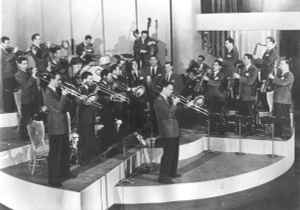Glenn Miller and his Orchestra was formed by trombonist, arranger, and composer Glenn Miller in 1938. Between 1939 and 1942, this orchestra was the best-selling dance band in the United States.
Miller was a sideman in many different groups, beginning in 1926 with the Ben Pollack Orchestra. He was overshadowed in Pollack's band by Jack Teagarden who began taking all of the trombone solos. Miller focused on arranging and composing, and by 1928 he had already published a songbook. Miller played frequently with other sidemen who would become famous in their own rights with their orchestras, Jimmy and Tommy Dorsey and Benny Goodman. Making some recordings with "Benny Goodman's Boys" in 1928 for Brunswick, Miller was a free-lance trombonist in several bands such as those of Red Nichols, Joe Venuti, and Nat Shilkret. From the early to mid 30's Miller served as an arranger and composer for the Dorsey Brothers Orchestra and made many recordings with Bing Crosby and The Boswell Sisters for Brunswick and Decca. In 1935 he assembled the American orchestra for Ray Noble.
Anxious to break out on his own, Miller formed his first orchestra in 1937 and made his first recordings as the Glenn Miller Orchestra for Brunswick, Vocalion (2) and Decca. By 1938, the band was unsuccessful and starving to death and disbanded. Miller revamped his style and arranging and created the second and massively popular Glenn Miller Orchestra.
In September 1938 the band made its first in a long list of recordings for Victor subsidiary Bluebird. In the spring of 1939, after a stint at the Meadowbrook Ballroom and Glen Island Casino, the orchestra's popularity soared. By 1939 Miller's band was tops in the jukeboxes and was the most popular orchestra until 1942 when Miller went into the service during WWII. From December 1939 to September 1942 Miller had a radio program broadcast three times a week. The band's records sold millions, and Miller was awarded the first Gold Record for "Chattanooga Choo Choo" in 1941. In addition, the band appeared in several motion pictures.
By Joel Whitburn's tabulation, in less than four years the group saw 16 US number-one hits, as well as 6 Australian number-ones (three of which didn't top the US charts). The amount of hit singles Miller and his Orchestra had in such a short amount of time proved to be one of the greatest chart runs in history. "In the Mood" became an anthem of the swing craze and the most lasting of even his biggest records. The group sold over 60 million records, the most of any dance band.
In the wake of Pearl Harbor, the very patriotic Miller joined the Army Air Forces where he would develop a modern military band for morale raising. The orchestra disbanded to a very emotional crowd at the Central Theater in Passaic, NJ on September 27, 1942. On December 15, 1944, Miller mysteriously disappeared over the English Channel. He was recognized as a war hero. The band's music never left the American public. Despite never recording a studio album, Miller and his Orchestra scored three posthumous Billboard number-one compilation albums as well as album certifications spanning several countries several decades after his death at age 40.
Use The Glenn Miller Orchestra for recordings WITHOUT Glenn Miller (who died in 1944).
See also: The New Glenn Miller Orchestra
